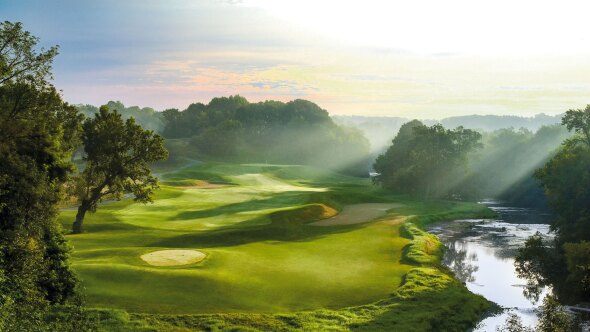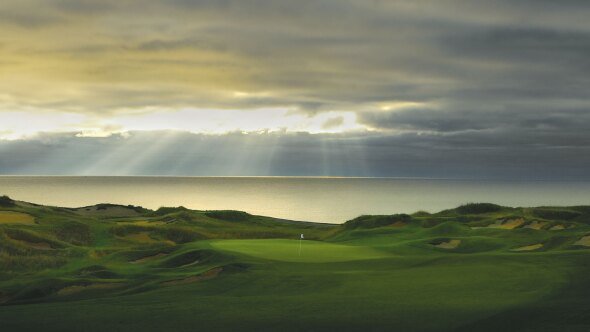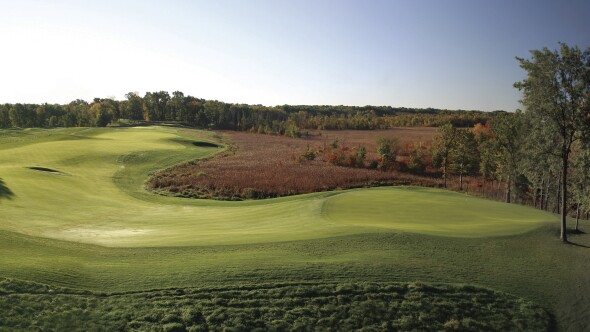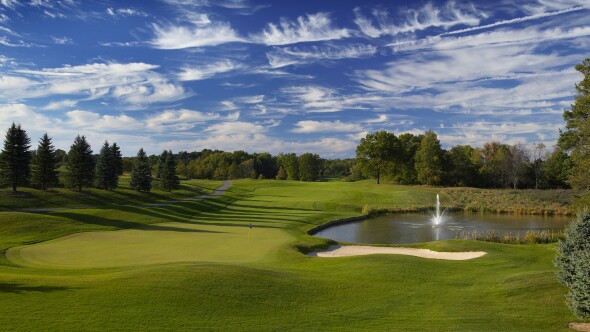Thoroughbred Golf Club at Double JJ Resort

About
Thoroughbred Golf Club is the centerpiece of the Double JJ Resort in Rothbury. It consistently ranks as one of West Michigan's top courses. The course is as beautiful as it is challenging with a landscape of lush rolling hills blanketed with mature trees. Golfers should be prepared for a variety of elevation changes and tricky uneven lies. Natural marsh areas come into play and there is a combination of conventional and pot bunkers, some with sod walls that make recovery difficult. Trees and mounding border the fairways and the challenging greens features a mix of ridges, tiers, and undulations. The no. 1 handicap hole is the second, which is both dramatically scenic and hard, This tough par 4 can be reached in regulation with a risky shot over the wetlands or it can be played safe to the right on the second shot.
| Tee | Par | Length | Rating | Slope |
|---|---|---|---|---|
| Gold | 72 | 6900 yards | 73.6 | 146 |
| Blue | 72 | 6359 yards | 71.3 | 138 |
| White | 72 | 5960 yards | 68.8 | 128 |
| Red (W) | 72 | 4879 yards | 68.3 | 121 |
| Hole | 1 | 2 | 3 | 4 | 5 | 6 | 7 | 8 | 9 | Out | 10 | 11 | 12 | 13 | 14 | 15 | 16 | 17 | 18 | In | Total |
|---|---|---|---|---|---|---|---|---|---|---|---|---|---|---|---|---|---|---|---|---|---|
| Gold M: 74.4/149 | 436 | 446 | 214 | 480 | 407 | 514 | 325 | 469 | 209 | 3500 | 531 | 181 | 347 | 407 | 371 | 428 | 358 | 184 | 580 | 3387 | 6887 |
| Blue M: 72.6/144 | 385 | 437 | 200 | 470 | 398 | 501 | 314 | 442 | 183 | 3330 | 512 | 157 | 313 | 400 | 354 | 348 | 344 | 167 | 565 | 3160 | 6490 |
| White M: 70.3/135 W: 76.7/147 | 376 | 409 | 185 | 438 | 376 | 406 | 302 | 405 | 155 | 3052 | 505 | 135 | 284 | 386 | 302 | 339 | 328 | 148 | 548 | 2975 | 6027 |
| Silver M: 67.8/130 W: 74.0/141 | 370 | 358 | 180 | 438 | 360 | 398 | 290 | 313 | 145 | 2852 | 426 | 125 | 231 | 374 | 286 | 330 | 312 | 121 | 458 | 2663 | 5515 |
| Red M: 64.2/122 W: 68.6/130 | 301 | 349 | 119 | 356 | 288 | 357 | 261 | 277 | 128 | 2436 | 426 | 113 | 226 | 256 | 242 | 276 | 288 | 95 | 458 | 2380 | 4816 |
| Handicap | 11 | 1 | 15 | 5 | 9 | 7 | 13 | 3 | 17 | 6 | 16 | 8 | 10 | 14 | 4 | 18 | 12 | 2 | |||
| Par | 4 | 4 | 3 | 5 | 4 | 5 | 4 | 4 | 3 | 36 | 5 | 3 | 4 | 4 | 4 | 4 | 4 | 3 | 5 | 36 | 72 |
Course Details
Rentals/Services
Practice/Instruction
Policies
Food & Beverage
RestaurantAvailable Facilities
Conference Facilities, Banquet FacilitiesAvailable Activities
Swimming, Riding, BilliardsReviews
Reviewer Photos
-
Photo submitted by nQXIh8QBMhT1dSIb6dRm on 07/28/2024
-
Photo submitted by nQXIh8QBMhT1dSIb6dRm on 07/28/2024
-
Photo submitted by u183373765 on 10/05/2023
-
18gold tip closed Photo submitted by u183373765 on 10/05/2023
-
Photo submitted by u183373765 on 10/05/2023
-
+ 9 morePhoto submitted by u183373765 on 10/05/2023
-
Photo submitted by u183373765 on 10/05/2023
-
Dylan hard at work!! Nice guy Photo submitted by u183373765 on 10/05/2023
-
Photo submitted by u183373765 on 07/24/2023
-
Photo submitted by u183373765 on 07/24/2023
-
Photo submitted by u183373765 on 07/24/2023
-
Photo submitted by u183373765 on 07/24/2023
-
Photo submitted by u183373765 on 07/24/2023
-
Photo submitted by u183373765 on 07/24/2023
-
Beginning of fairway - hole #2 Photo submitted by u000007521173 on 07/09/2013
Fabulous Golf
Double JJ Ranch Thoroughbred Golf Course is an absolute gem and a must-play for any golf enthusiast. This PGA Championship quality course is set in a pristine environment, surrounded by majestic trees and a stunning lake, offering breathtaking views at every turn. The beauty of the course makes it feel like a private sanctuary, easily one of the prettiest golf courses in the area.
The experience is further enhanced by the super friendly staff, especially Barb in the pro shop, who goes out of her way to make everyone feel welcome. The senior discounts are a great touch, making it more accessible for older golfers. The addition of a new GPS range system on the golf carts is a fantastic upgrade, ensuring you have all the information you need to play your best game.
Overall, Double JJ Ranch Thoroughbred Golf Course combines top-notch facilities with a spectacular setting, creating an unforgettable golfing experience. Highly recommended!
Difficult Art Hills Couo
One of the more difficult public courses in the state. There is not much room on many holes off the fairway.
Love the scenic layout and undulating greens. Must play if you want a challenge.
Coming back in shape nicely!!
OK we were just here if you want to go in the end of July when they re-opened up and the greens were horrible but now I’m playing October 5 Thursday only one on the course unbelievable and the greens are at least twice as nice and twice as fast as they were so they’re making their way back. The fairways are coming back really nice. The tea boxes are still a little spongy and a lot of moles, and so forth but the fairways and greens are are coming back. That’s the great news is still $25 played by myself in less than three hours from the blues Shotwell And the bones of this course are just still fantastic from Arthur Hills. I don’t know how I stay in business I’m the only one in the Sundance salon having lunch at 3 o’clock maybe I don’t know I don’t have a reason why this place just does not get any business here. It’s only work 20 minutes from Muskegon an hour from Grand Rapids I drove almost an hour to get here but it’s worth it the serene, peaceful quietness and you’re by yourself gorgeous Arthur hills, Leo And only $25 and now I’m gonna have a nice signature burger at the salon which is very nice also so unfortunately I have nothing but good to say but we need to get some people here so they stay in business. They did invest a lot of money and clearing out the brush cutting down a bunch of scrub stuff back in the spring, so there are spending money on the course get up here and play Arthur Hills, Thoroughbred
-
Photo submitted by u183373765 on 10/05/2023
-
18gold tip closed Photo submitted by u183373765 on 10/05/2023
-
Photo submitted by u183373765 on 10/05/2023
-
Photo submitted by u183373765 on 10/05/2023
-
Photo submitted by u183373765 on 10/05/2023
-
Dylan hard at work!! Nice guy Photo submitted by u183373765 on 10/05/2023
Horse is an awful shape, but just reopened had irrigation issues last year and they may still have those waterlogged, but Arthur Hills did a fantastic
Oh, we came on Thursday, July 20, 2023 and they just reopened after being close last year for irrigation issues. OK the course is still in really rough shape but it’s on the mend. The biggest improvement is that they Musta hired a company to do a lot of brush hog, trim work all around the course which opened things up fantastically at least the reinvesting into the course. I do not really encourage playing it right now. It was just the only thing that reopened in that it was $25 each if the course is in Primo shape of beer $75 course played hear back in 1997 and it wasn’t Primo shape and we used to come up late in the afternoon for a twighlight about the same price of $25. Has the most elevation change of most any course around feels like you’re way up north and hilly as can be Arthur hills really utilized the layout of the land here to the max and if you play from the Tips you better bring Reagan because it’s a 149 slope rating issue so I would encourage to wait maybe a year right now is not the time but we could still have fun playing there it’s just in really bad shape. Unfortunately the greens were super shaggy waterlogged, plugging, etc. but the food is good at the steakhouse, so go for.
Golf
Fairways and greens were good but off the fairway alot of thick quack grass. Narrow in places accuracy is important. Lots of woods to enjoy and fall colors.
Need a Marshall
Nice track, greens were in good shape, but the pace of play was way too slow. Finally we skipped a hole and a guys said, "oh, we didn't realize were holding everyone up. I guess we could pick it up a little." If there had been a Marshall pushing a little it would have been great.
Tranquil round
This course is not easy by any means, but it is always in good shape, the only crazy hole is #2, an extremely difficult that is a little extreme in my mind. Every hole on the course is away from other holes which is wonderful, so you are almost alone all the time as you play a hole! I have here many times, and I will always come back when I am on the west-side of the state.
Enjoyable course
Typically good Arthur Hills course. Challenging but fair. Great greens and overall in good condition but tees and bunkers could use some additional attention. Need to keep the ball straight, thick trees and lots of swamps. Each hole is completely by itself, you never see another hole. Very secluded. Heavy rain the day we played so we were by ourselves on the course. Course drained well and service was excellent. Great rate (hot deal) on Golf Now.
TLC
Staff very friendly. Course has some great holes and is a nice layout. Some blind shots but course book was very helpful. Overall a good value, course itself could just use a little TLC. But considering everything would definitely play there again.
Best greens around. New pro Chris is awesome and very accommodating. I actually live on a course nearby and plan on moving to this course next year 20 minutes away from home.
Just Okay. Rather gimmicky with some Mickey Mouse greens.
Definitely requires course knowledge. Few holes are rather gimmicky, meaning just poor design. A few greens were like miniature golf, only missing the clown face. Bring a very good GPS system with you. Overall, I wouldn't rush to play here again.
Don't miss it
Golf Now had a great price so we thought we would try something new. Wonderful layout, great condition on greens and fairways. Don't be disappointed with a poor score, it is long and difficult, enjoy the surroundings. Wooded and hilly but a ton of fun. Don't miss it!
Another perfect morning
We were able to get the first tee time on Monday, my son and in played 18 in 3 hours and 15 minutes and enjoyed what I consider to be the best course in the West Michigan, the conditions were perfect, the greens were fresh cut and when we arrived at 7:00 the pro brought us out our cart as we pulled in. Course layout, condition and service all in one package, well done.
Beautiful course
Was an excellent deal for this nice course greens were in great shape



























